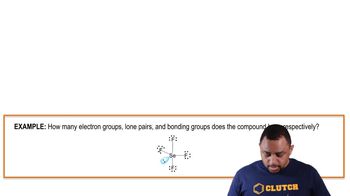Which species has the smaller bond angle, H3O+ or H2O? Explain.
Ch.11 - Chemical Bonding II: Molecular Shapes, VSEPR & MO Theory

All textbooks Tro 5th Edition
Tro 5th Edition Ch.11 - Chemical Bonding II: Molecular Shapes, VSEPR & MO Theory
Ch.11 - Chemical Bonding II: Molecular Shapes, VSEPR & MO Theory Problem 39d
Problem 39d
 Tro 5th Edition
Tro 5th Edition Ch.11 - Chemical Bonding II: Molecular Shapes, VSEPR & MO Theory
Ch.11 - Chemical Bonding II: Molecular Shapes, VSEPR & MO Theory Problem 39d
Problem 39dChapter 11, Problem 39d
Determine the molecular geometry and sketch each molecule or ion using the bond conventions shown in 'Representing Molecular Geometries on Paper' in Section 10.4. d. IBr4-
 Verified step by step guidance
Verified step by step guidance1
Determine the total number of valence electrons for IBr_4^-.
Identify the central atom and arrange the other atoms around it.
Use the VSEPR theory to determine the electron-pair geometry.
Determine the molecular geometry based on the positions of the atoms.
Sketch the molecular geometry using the bond conventions.

Verified video answer for a similar problem:
This video solution was recommended by our tutors as helpful for the problem above.
Video duration:
1mWas this helpful?
Key Concepts
Here are the essential concepts you must grasp in order to answer the question correctly.
VSEPR Theory
Valence Shell Electron Pair Repulsion (VSEPR) Theory is a model used to predict the geometry of individual molecules based on the repulsion between electron pairs in the valence shell of the central atom. According to VSEPR, electron pairs will arrange themselves as far apart as possible to minimize repulsion, leading to specific molecular shapes. This theory is essential for determining the geometry of molecules like IBr4-.
Recommended video:
Guided course

Molecular Shapes and VSEPR
Molecular Geometry
Molecular geometry refers to the three-dimensional arrangement of atoms within a molecule. It is determined by the number of bonding pairs and lone pairs of electrons around the central atom. For IBr4-, understanding its molecular geometry helps in visualizing how the iodine atom is surrounded by four bromine atoms and the influence of lone pairs on the overall shape.
Recommended video:
Guided course

Molecular Geometry with Two Electron Groups
Bonding and Lone Pairs
In molecular structures, bonding pairs are the pairs of electrons shared between atoms, while lone pairs are the pairs of valence electrons that are not involved in bonding. The presence of lone pairs can significantly affect the molecular geometry by altering bond angles and overall shape. For IBr4-, the presence of two lone pairs on the iodine atom is crucial for determining its square planar geometry.
Recommended video:
Guided course

Electron Groups, Lone Pairs, and Bonding Groups Example
Related Practice
Textbook Question
Textbook Question
Which species has the smaller bond angle, ClO4- or ClO3- ? Explain.
Textbook Question
Determine the molecular geometry and sketch each molecule or ion using the bond conventions shown in 'Representing Molecular Geometries on Paper' in Section 10.4. c. IF2-
Textbook Question
Determine the molecular geometry and sketch each molecule or ion, using the bond conventions shown in 'Representing Molecular Geometries on Paper' in Section 10.4. b. SCl6
Textbook Question
Determine the molecular geometry and sketch each molecule or ion, using the bond conventions shown in 'Representing Molecular Geometries on Paper' in Section 10.4. c. PF5
1
views
Textbook Question
Determine the molecular geometry and sketch each molecule or ion, using the bond conventions shown in 'Representing Molecular Geometries on Paper' in Section 10.4. d. IF4+